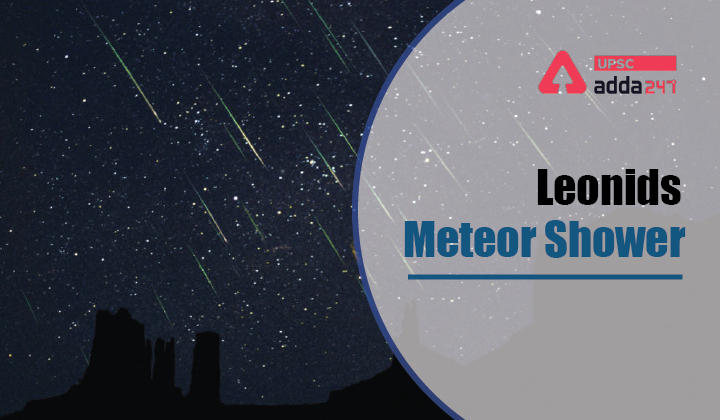”GS Paper – 3: Space Technology”
Why in News?
- The annual Leonids Meteor Shower has begun. This year’s shower is active between November 6 and 30, with peak activity expected on November 17.
- Leonids Meteor Shower is an annual spectacle in the night sky in November. It turns into a meteor storm every 33 years or so.
- The peak time of a meteor shower comes when the Earth passes through the densest part of the debris.
About Leonids:

- The Leonids are considered to be a major shower that features the fastest meteors, which typically travel at speeds of 71 km per second, although the rates are often as low as 15 meteors per hour.
- The Leonids are also called fireballs and earthgazer meteors. Fireballs, because of their bright colours, and earthgazer, because they streak close to the horizon.
- The light—which is why a meteor is called a shooting star — is a result of the friction between the meteorite and the molecules present in the Earth’s atmosphere because of which it burns.
Meteor Storm:
- Every 33 years, a Leonid shower turns into a meteor storm, which is when hundreds to thousands of meteors can be seen every hour.
- A meteor storm should have at least 1,000 meteors per hour.
- In 1966, a Leonid storm offered views of thousands of meteors that fell through the Earth’s atmosphere per minute during a period of 15 minutes.
- The last such storm took place in2002.
Are the Meteor showers Visible?
- The showers are visible on any cloudless night when the Moon is not very bright.
- Ideally, the viewing location should have no light pollution; the farther away from cities the better.
Where Do Meteors Come From?
- Meteors come from leftover comet particles and bits from broken asteroids.
- When comets come around the sun, the dust they emit gradually spreads into a dusty trail around their orbits.
- Every year the Earth passes through these debris trails, which allows the bits to collide with our atmosphere where they disintegrate to create fiery and colourful streaks in the sky.
The Comet:
- The pieces of space debris that interact with our atmosphere to create the Leonids originate from comet 55P/Tempel-Tuttle.
- It takes comet Tempel-Tuttle 33 years to orbit the sun once.
Are Leonids Dangerous?
- While most Leonid meteors are no larger than grains of sand, some may be as large as a meter in diameter.
- Most Leonids will burn up in the upper atmosphere, posing no danger to humans on Earth.



 TSPSC Group 1 Question Paper 2024, Downl...
TSPSC Group 1 Question Paper 2024, Downl...
 TSPSC Group 1 Answer key 2024 Out, Downl...
TSPSC Group 1 Answer key 2024 Out, Downl...
 UPSC Prelims 2024 Question Paper, Downlo...
UPSC Prelims 2024 Question Paper, Downlo...
